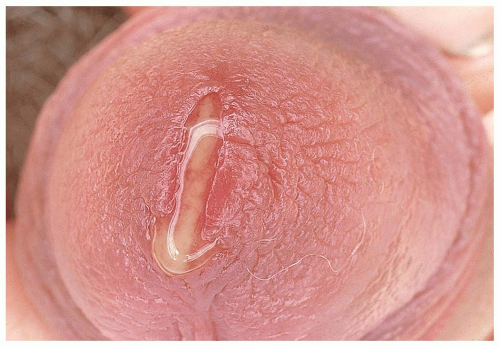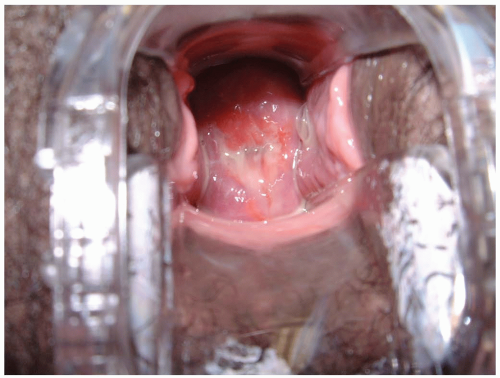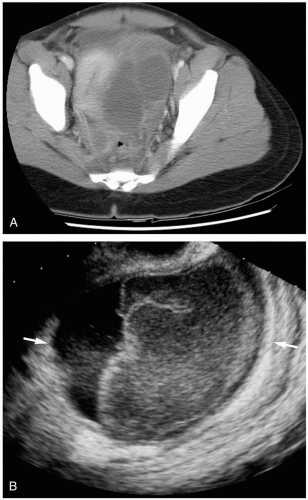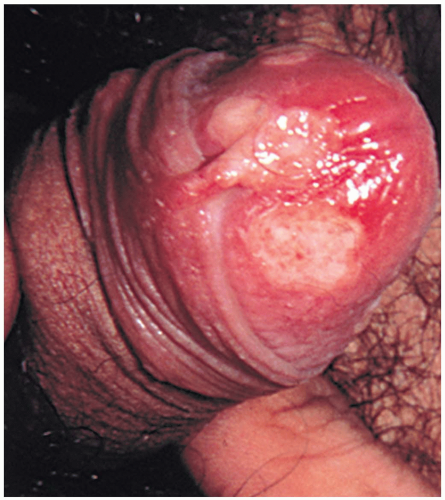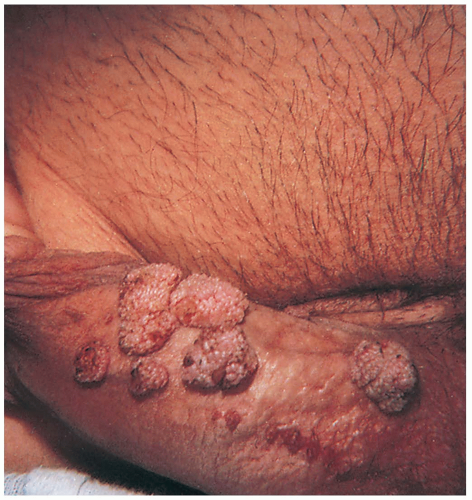Sexually Transmitted Diseases
12-1 Urethritis
Dziwe Ntaba
Clinical Presentation
Patients with urethritis present with painful urination and a urethral discharge. Urethral itching is also common; however, many patients are relatively asymptomatic. Presenting symptoms may also include urinary frequency and urgency.
Pathophysiology
The most likely single etiologic agent causing acute urethritis is Neisseria gonorrhoeae (GCU). However, nongonococcal urethritis (NGU) is twice as common and is associated with greater morbidity than GCU. Chlamydia species are the predominate organisms involved in NGU; others include Ureaplasma spp., Trichomonas spp., and herpes simplex virus. Noninfectious causes of urethritis include Reiter’s syndrome and Kawasaki disease. Traumatic urethritis is caused by an inflammatory reaction to the insertion of a foreign body, medical instrument, or urinary catheter.1
Diagnosis
A complete genitourinary examination is indicated. Suggestive findings include clear to yellow-brown discharge, meatal edema, and tenderness to palpation along the course of the urethra (in men). Consideration of possible joint or eye involvement is essential. Laboratory evaluation includes urinalysis, urethral swab for gonorrhea and chlamydia, cultures, and Gram staining. Ideally, swabs should be obtained at least 2 hours after voiding, to prevent bacterial washout. A complete absence of white blood cells on the urethral smear argues against urethritis.1
Clinical Complications
Complications include pelvic inflammatory disease (PID) in women, prostatitis in men, disseminated gonococcal disease in both sexes, and epidemiologic spread within a community. Gonorrhea is highly infectious: a single episode of unprotected intercourse with an infected partner carries an 80% transmission risk to women, and 20% to men. The pharynx is involved in 40% of homosexual men and 7% of heterosexuals with GCU.2 Notification of public health authorities, patient education regarding risks of reinfection, and referral of sexual partners are essential.
Management
Treatment for uncomplicated cases of urethritis is empirically geared toward coverage of both GCU and NGU, because coinfection is common. Single doses of ceftriaxone or of ciprofloxacin are recommended for GCU, although recent reports show a rise in quinolone-resistant N. gonorrhea. For NGU, azithromycin and doxycycline are equally efficacious.2
REFERENCES
1. Lundquist ST, Stack LB. Diseases of the foreskin, penis, and urethra. Emerg Med Clin North Am 2001;19:529-546.
2. Workowski KA, Levine WC. Sexually transmitted diseases treatment guidelines—2002. MMWR Morb Mortal Wkly Rep 2002;51(RR-6):1-80.
12-2 Pelvic Inflammatory Disease
Anthony Morocco
Clinical Presentation
Patients with pelvic inflammatory disease (PID) present with a variety of symptoms, alone or in combination, including vaginal discharge, abdominal pain, dyspareunia, vaginal bleeding, dysuria, malaise, nausea, vomiting, and fever.
Pathophysiology
Various bacteria have been implicated in the pathogenesis of PID, including N. gonorrhoeae, Chlamydia trachomatis, Haemophilus influenzae, enteric bacteria (e.g., Bacteroides fragilis), Streptococcus agalactiae, cytomegalovirus (CMV), Mycoplasma hominis, and Ureaplasma urealyticum. Most cases of PID are probably caused by ascending infections of the lower genital tract.1,2
Diagnosis
The diagnosis can be difficult, and it is likely that many mild cases go unrecognized. Although most cases are diagnosed on clinical grounds, the gold standard for diagnosis is laparoscopy.1 Physical findings include fever, tachycardia, abdominal tenderness, cervical motion tenderness, and bilateral adnexal tenderness. Guarding and rebound tenderness may be present on abdominal examination.2 Minimal criteria for the clinical diagnosis include adnexal tenderness or cervical motion tenderness in a sexually active woman for which no other cause can be found. Supportive findings include oral temperature greater than 38.3°C, vaginal discharge, white blood cells on saline preparation of vaginal fluid, laboratory evidence of N. gonorrhoeae or C. trachomatis infection, elevation in C-reactive protein, and increased erythrocyte sedimentation rate (ESR). The positive predictive value of a clinical diagnosis ranges from 65% to 90%.1
Clinical Complications
The most common complications are related to damage and scarring of the upper genital tract, which can result in infertility, future ectopic pregnancies, and chronic pelvic pain. Other complications include tubo-ovarian abscess (TOA) and Fitz-Hugh-Curtis syndrome.2
Management
The decision to treat PID on an inpatient rather than an outpatient basis is founded on factors such as pregnancy, failure of initial outpatient treatment, inability to follow oral antibiotic regimen, severe clinical illness, presence of TOA, and the potential presence of a serious alternative diagnosis (e.g., appendicitis).1,2 Antimicrobial therapy should be broad-spectrum and directed at all the potential pathogens. Inpatient first-line therapy is cefoxitin or cefotetan, plus doxycycline or clindamycin, plus gentamicin. Outpatient therapy is ofloxacin or levofloxacin, or intramuscular ceftriaxone and oral doxycycline; either regimen may be given with or without metronidazole.1 Clinicians should consult current recommendations of the Centers for Disease Control and Prevention (CDC) for dosages and applicable duration of therapy.
REFERENCES
1. Workowski KA, Levine WC. Sexually transmitted diseases treatment guidelines—2002. MMWR Morb Mortal Wkly Rep 2002;51(RR-6):1-80.
2. Zeger W, Holt K. Gynecologic infections. Emerg Med Clin North Am 2003;21:631-648.
12-3 Tubo-ovarian Abscess
Dziwe Ntaba
Clinical Presentation
Tubo-ovarian abscess (TOA) is a common complication of pelvic inflammatory disease (PID), with a clinical presentation similar to that of salpingitis (i.e., abdominal pain, fever, and gastrointestinal symptoms).
Pathophysiology
TOA is present in as many as 15% of women with PID and in approximately 33% of those requiring hospitalization for PID. TOA is less prevalent among postmenopausal women. The most common pathogens isolated from operative cultures are Escherichia coli, Bacteroides, and Streptococcus. Neisseria and Chlamydia species are less commonly isolated, but this may reflect selection bias among published case reports or among those cases requiring surgical intervention.1
Diagnosis
Historical clues to the presence of TOA include one or more previous episodes of PID and the presence of an intrauterine device.1 Physical examination usually reveals lower abdominal tenderness, cervical and adnexal tenderness, and the perception of adnexal fullness on pelvic examination. The diagnosis is confirmed by transvaginal sonography, which demonstrates a well-demarcated, tubular structure with thick, dense walls containing heterogeneous fluid-debris levels. If free fluid is seen, or if peritoneal signs are present on examination, computed tomography (CT) of the abdomen is indicated. Transabdominal ultrasonography may be confounded by bowel gas and body habitus.2 Some authors recommend the routine use of ultrasonography in all patients admitted to the hospital with PID.3 Laparoscopy is the diagnostic gold standard.
Clinical Complications
Complications include rupture and subsequent sepsis as well as septic shock. Posttreatment risks for ectopic pregnancy and infertility are substantial.
Management
Given the polymicrobial spectrum seen in TOA, triple therapy with ampicillin, gentamicin, and clindamycin has shown to be cost-effective. Surgery is required in all cases of TOA rupture, or failure of medical treatment.2
REFERENCES
1. El Khoury J, Stikkelbroeck MM, Goodman A, Rubin RH, Cosimi AB, Fishman JA. Postmenopausal tubo-ovarian abscess due to Pseudomonas aeruginosa in a renal transplant patient: a case report and review of the literature. Transplantation 2001;72:1241-1244.
2. Lee C, Henderson SO. Emergent surgical complications of genitourinary infections. Emerg Med Clin North Am 2003;21:1057-1074.
3. McNeely SG, Hendrix SL, Mazzoni MM, Kmak DC, Ransom SB. Medically sound, cost-effective treatment for pelvic inflammatory disease and tuboovarian abscess. Am J Obstet Gynecol 1998;178:1272-1278.
12-4 Chancroid
Colleen Campbell
Clinical Presentation
Patients with chancroid may describe a history of preceding malaise for several days before the appearance of genital ulcers. Patients present with painful genital ulcers surrounded by erythema. Men usually present with one or more ulcers on the prepuce or frenulum, whereas women may present with ulceration involving the vulva, cervix, or perianal area.1 Tender, unilateral lymphadenopathy is a common associated presenting complaint.
Pathophysiology
Chancroid, a sexually transmitted disease caused by Haemophilus ducreyi, is characterized by necrotizing genital ulcers. H. ducreyi is a fastidious, gram-negative organism.1 Human immunodeficiency virus (HIV) infection is associated with a higher rate of chancroid infection. Men develop chancroid more commonly than women do. The ulcer begins as an erythematous papule about 4 days after exposure and progresses to ulceration after pustule rupture. There may be obvious bubo formation in the inguinal regions.
Diagnosis
The diagnosis of chancroid should be considered in all patients with painful genital ulcers characterized by irregular, inverted, and granulomatous borders. Physical examination, even when performed by experienced clinicians, is a relatively insensitive and nonspecific indicator of disease.1 Multiplex polymerase chain reaction (M-PCR) tests exist and are a very sensitive means to differentiate chancroid from syphilis, but they are expensive and not widely available. Culture only approaches 75% sensitivity, because H. ducreyi is an extraordinarily fastidious microaerophilic organism.
Clinical Complications
Management
Effective treatment may be achieved by the use of ciprofloxacin, ceftriaxone, or erythromycin. The cure rate associated with these drugs is greater than 90%; ceftriaxone and erythromycin are a safer alternative during pregnancy.1 Azithromycin and spectinomycin are other single-dose treatment regimens recommended by the World Health Organization (WHO) and the Centers for Disease Control and Prevention (CDC).1 Prolonged courses of treatment may be necessary for patients with concomitant infection.2 Healing of the ulcer can take up to 3 weeks. Notification and testing of sexual contacts is mandatory.
REFERENCES
1. Lewis DA. Chancroid: clinical manifestations, diagnosis, and management. Sex Transm Infect 2003;79:68-71.
2. Sehgal VN, Srivastava G. Chancroid: contemporary appraisal. Int J Dermatol 2003;42:182-190.
12-5 Condyloma Acuminata
Michael Greenberg
Clinical Presentation
Pathophysiology
CA are external genital warts that are caused by infection with the human papillomavirus (HPV). Some 80 strains of HPV have been identified, and 30 of these cause genital infection. The incidence of CA ranges from 0.5% to 1% among sexually active young adults in the United States. There are reportedly up to 1 million new cases annually. Adolescents, young adults, and persons with multiple partners are at highest risk for infection. There is no evidence that condoms prevent the spread of HPV, and HPV may be spread by a variety of sexual activities beyond intercourse. The risk for cervical intraepithelial neoplasia in women infected with HPV is increased. Passive and active cigarette smoke exposure are strongly associated with HPV expression.1,2
